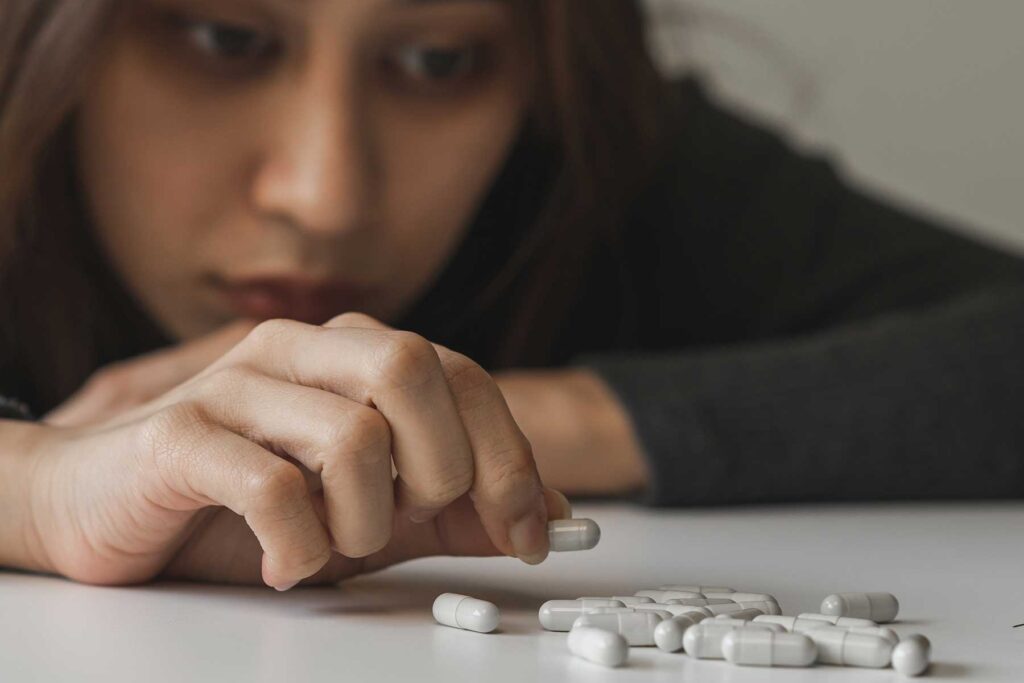If you or a loved one are struggling with opioid addiction, seek professional help. Call 844.875.5609 to speak with someone from Promises Behavioral Health about how opioid use can affect your looks, how to spot signs of opioid use, and how our opioid addiction treatment program throughout the United States can help you or a loved one.
How Opioid Use Affects Your Looks
Despite heroin use impacting people of all socioeconomic strata, from Middle America to Hollywood, the stereotypical image of a heroin addict persists. Many still think of heroin users as painfully thin individuals with track marks up and down their arms. Although opioid abuse comes with serious short- and long-term side effects, some drug-related changes in appearance might be more accurately attributed to a reckless lifestyle. For example, some users forgo food to buy drugs. The visual signs of opioid use often involve the skin and the eyes.
Skin
Commonly called track marks, vascular scarring is typically found on the hands, arms, and legs but can be found anywhere on the body where there are veins. Fresh track marks are unhealed wounds from intravenous drug use. Continued injection in the same area can cause scarring, dark pigmentation at the injection site, damage to the veins, lesions, and bruising. In addition to the visible marks, using dirty needles can cause serious skin infections, such as:
- Cysts
- Abscesses
- Ulcers
Heroin abuse can also lead to rapid weight loss, sagging skin, and loss of healthy body fats, while prescription opioids can cause weight gain or loss. Chronic heroin use can result in a loss of skin radiance due to dryness, poor nutrition, and personal hygiene. Many heroin users have cool, moist, and pale skin with dark circles under their eyes. It’s also common for chronic users to appear much older than their actual age, with deeply etched lines on their faces.
Oxycodone is associated with flushing so users may experience temporary facial redness. Opioids can cause severe itching, so some users develop scabs, acne, open sores, and scarring. Research suggests MRGRPX2, a receptor protein on the surface of mast cells, can trigger the immune system response that results in opioid itching. Although these are rare side effects, hydrocodone with acetaminophen can cause acute pustular skin eruptions, discolored spots, small elevations on the skin, and giant hives.
Eyes
Oxycodone and illicit opioids can cause pinpoint pupils and bloodshot eyes. Opioid abuse can result in constricted pupils or miosis because the drugs stimulate the parasympathetic nerve in the brain. One of the most unusual routes of heroin injection is the eye, which can result in severe repercussions, including ophthalmic vein thrombosis and lesions.
Although opioid effects include changes in appearance, their addictive nature can lead to even more severe health issues. Opioid addiction treatment is essential to break the vicious cycle and prevent heroin and prescription opioids from inflicting permanent damage.
What to Expect from Opioid Addiction Treatment
As you learn how opioid use affects your looks and health, motivating yourself to seek treatment becomes easier. Opioid addiction treatment programs focus on helping individuals overcome opioid dependence, minimize the risk of relapse, and improve their physical and emotional health. A comprehensive approach to opioid addiction includes the following:
- Medical detox
- Medication management
- Holistic therapies
- Individual and group counseling
- Family education and support
- Aftercare planning
At Promises Behavioral Health, our comprehensive approach to opioid addiction treatment helps individuals reclaim their lives while providing them with the tools they need to maintain a lifetime of sobriety.
Find Opioid Addiction Treatment with Promises Behavioral Health
Contact Promises today at 844.875.5609 to learn more about how opioid use affects your looks and the signs to look out for. We offer comprehensive, evidence-based treatment programs throughout the United States. Our caring and compassionate team is here to help you or a loved one get sober and stay sober.

